This traditional Punjabi Saag Paneer recipe is pure magic! Soft paneer chunks in a creamy mustard greens and spinach curry. Every bite of this classic Indian curry will melt in your mouth.
Most importantly, it’s easy and doesn’t require lots of ingredients.

Saag Paneer is the more character-laden cousin of Palak Paneer, made with mixed greens like mustard leaves (sarson) instead of spinach alone.
The velvety texture and subtle spicing of this recipe for Saag Paneer ensures the peppery mustard leaves and juicy paneer are the true stars of the show.
What is saag called in English?
The English name for ‘saag’ is simply ‘greens’. ‘Sarson ka saag’ specifically translates to ‘mustard leaves or mustard greens’.
What’s the difference between Saag Paneer and Palak Paneer?
You may or may not know that Saag Paneer and Palak Paneer are two completely different dishes. The names are often used interchangeably which can be misleading.
Indian restaurants and big supermarkets are usually the worst offenders when it comes to making this mistake. Let me explain the difference here.
Greens used for Saag
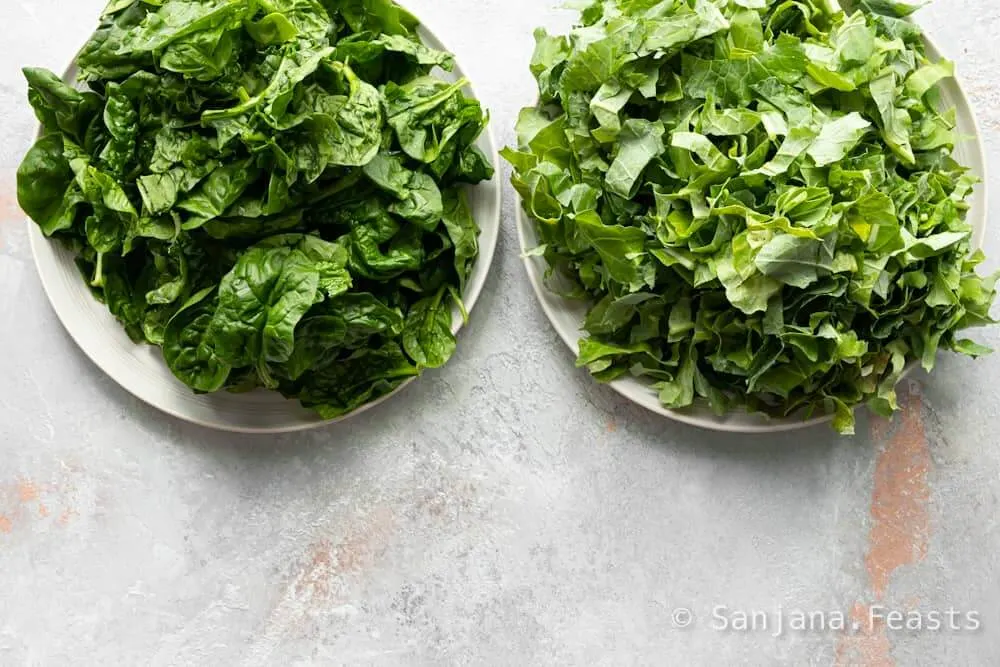
Saag is a dish is made from a combination of leafy greens. It usually includes mustard leaves but can also feature bathua (goosefoot), chaulai (amaranth), methi (fenugreek) and chane ka saag (chickpea leaves). Each one has a distinct flavour.
Ultimately, saag refers to a combination of mixed greens which can include, but are not always limited to spinach. The dish is made from only spinach leaves and paneer is called Palak Paneer.
Saag Paneer vs. Palak Paneer. Why does it matter?


You know how people always confuse Shepherd’s Pie and Cottage Pie? Well, many mix up Saag Paneer and Palak Paneer in the same way. Each is made using different ingredients which means they have very unique flavours.
Not all greens taste the same so the combination of leaves used can make a HUGE difference in the finished dish. I’m always disappointed when I order Saag Paneer and get bowl of Palak Paneer.
What do mustard leaves (sarson ka saag) look like?

Palak Paneer definitely doesn’t have the same peppery kick from the mustard greens as Saag Paneer does.
Where to buy mustard leaves (saag)
Saag is sold in bunches, similar to mature spinach in South Asian grocers. Try looking near the spinach, fenugreek and coriander. If you’re unsure of what you’re looking for, you can always ask the shopkeeper.
In terms of appearance, mustard greens have large, robust leaves with serrated-looking edges. The colour of the leaves is a deep green/blue. You can eat both the leaves and stalks.
Check your local Indian grocer for sarson ka saag.
How to cook mustard leaves
The best way to cook mustard leaves is the Indian way. Saag, like this traditional Punjabi Saag recipe, or this Saag Paneer recipe are some of the most flavorful ways you can cook mustard leaves.
Think of it like an Indian creamed spinach but with a LOT more of a kick.
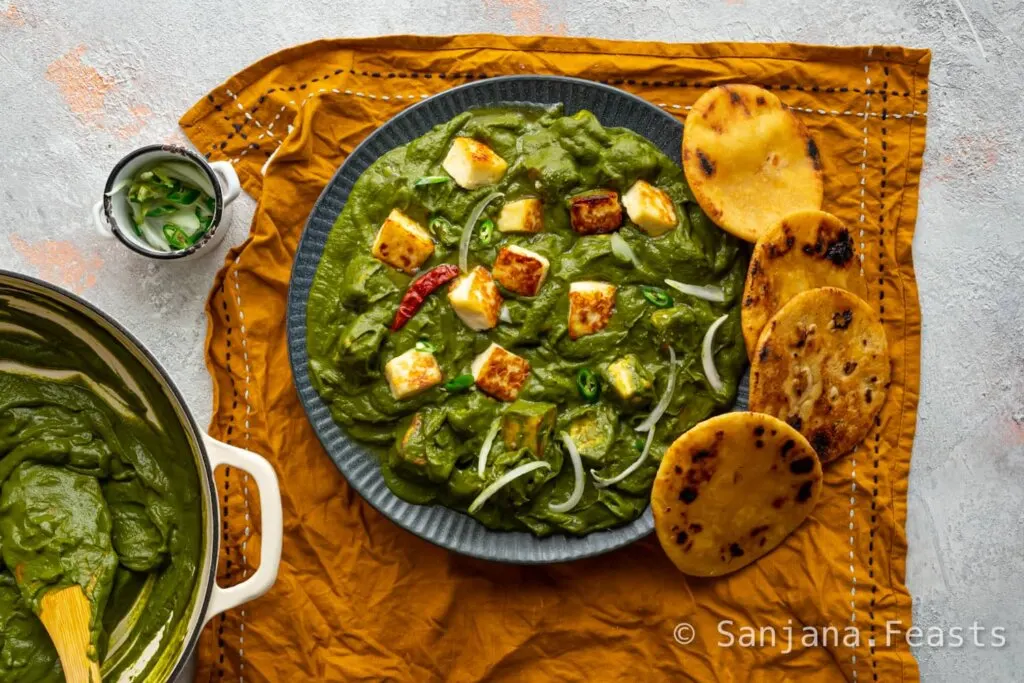
What does Saag Paneer taste like?
Saag Paneer is traditionally quite a simple North Indian preparation of mixed greens and cottage cheese (paneer).
The spices are quite minimal in comparison to a lot of Indian curries. However, it is often rich in either ghee or butter, as well as onions, garlic, ginger and garam masala. Green chillies add ample heat, too.
Can I use shop-bought paneer?
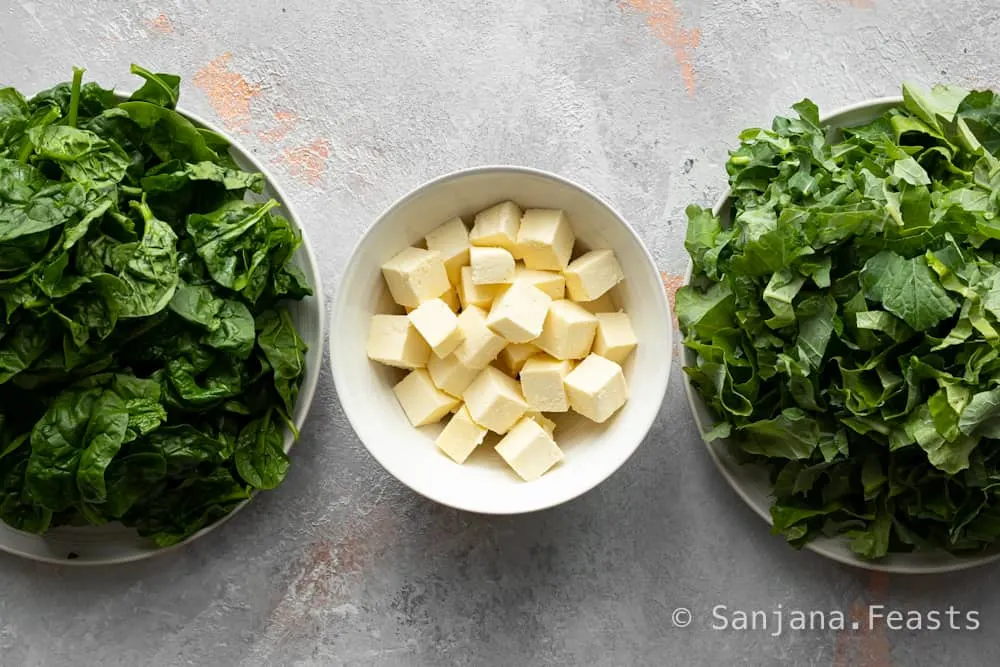
The short answer is yes. In fact, I encourage it. You don’t have to make your own paneer for this recipe unless you really want to.
If you do want to make your own paneer, head on over to my Homemade Paneer video for an easy step-by-step tutorial.

Can I eat paneer raw?
Yes! While it’s a good idea to heat paneer through before you eat it, there is absolutely no requirement to pre-cook paneer prior to adding it to a curry.
Some people choose to shallow fry or deep fry paneer to give it some colour and texture. This will also help very soft paneer retain its’ shape in a liquid gravy.

You can also choose to soak paneer in hot water if you like it soft and milky. I often like to do a reverse soak method. I’ll describe the process below.
How to make paneer soft: The reverse soak method
Many curry recipes will call for paneer to either be fried or soaked prior to adding it to the gravy. While neither of these steps are necessary, they can improve the overall texture of the paneer for a more enjoyable eating experience.
The reverse soak method is something I’ve done for years and it produces amazingly soft paneer, with an appetising golden colour on the outside.

First, pan-fry the paneer in oil until golden on all sides. This will give the paneer a lovely seared colour on the outside, as well as help it hold its’ shape.
Place the fried paneer in a bowl and pour boiling hot water on top, until all the cheese is submerged.
This second step will not only make the paneer beautifully soft on the inside, but it will also remove any excess fat from frying.
This is a technique I swear by and you can use it for other paneer-based Indian curry recipes like Paneer Makhani, Matar Paneer, Shahi Paneer and Paneer Butter Masala.

Since paneer does not stay crispy in a curry/gravy, there’s no need to worry about it softening on the outside.
A bit about pressure cookers
I adore my pressure cooker. I’ve had one since I can remember because it’s so handy for making everyday Indian food. I use my pressure cooker for daal, curry, khichdi and more. It’s definitely one of my most prized possessions in the kitchen!



How to cook saag in a pressure cooker
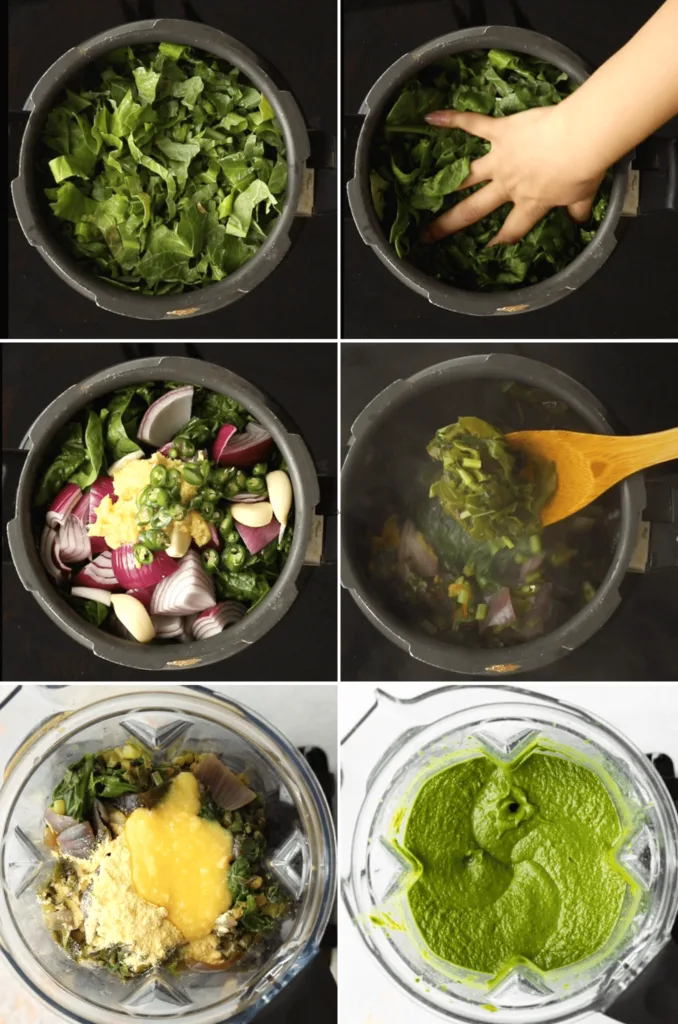
In this recipe, the pressure cooker breaks down the saag and aromatics in just 10 minutes.
How to cook saag in an Instant Pot
If you have an Instant Pot (or equivalent pressure pot), the saag takes around 5 minutes to cook on high power.
Make saag paneer without a pressure cooker

If you don’t have either, bring everything to the boil in a large stock pot and cover with a lid. Cook for 30 minutes until everything is tender. A small pinch of baking soda really helps break the leaves down quickly and evenly.
How to make vegan Saag Paneer
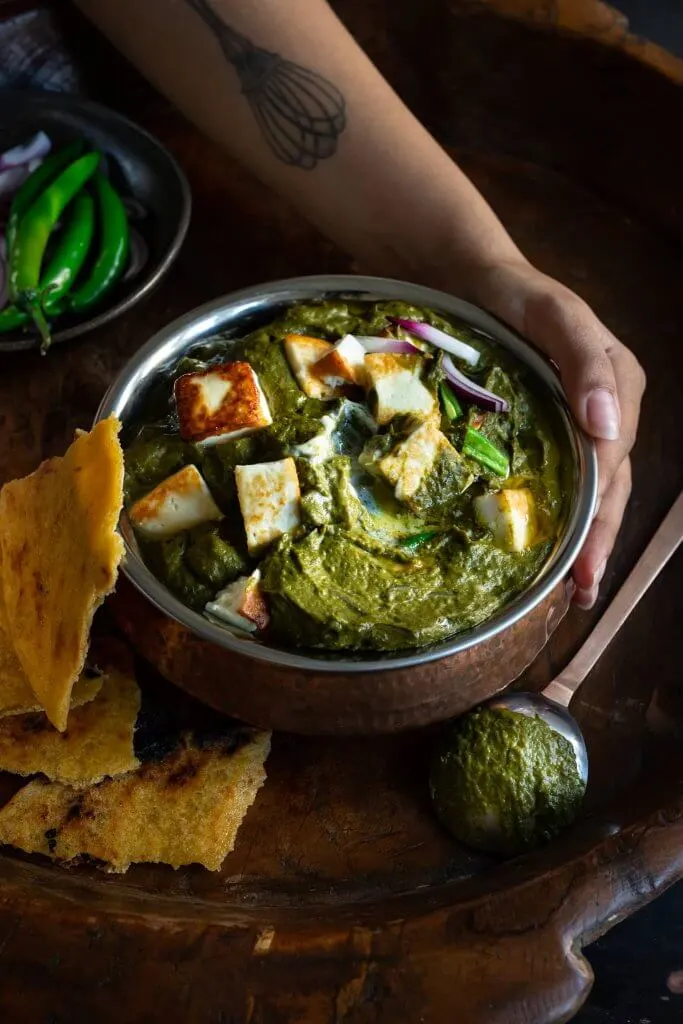
Simple! To make vegan Saag Paneer, switch the paneer for fried firm tofu cubes. Replace the ghee in the recipe with your favourite plant-based spread or vegan block.

Do I need a blender to make Saag Paneer?


My recipe calls for a blender because it makes quick work of creating a smooth sauce. For that reason, I use a high-powered blender like a Vitamix. However, you can use any blender you have, including a stick blender.
It’s also fine to serve the Saag Paneer chunky if that’s what you like. In Northern India (where Saag Paneer comes from), people chop all the greens and aromatics finely before cooking the saag low and slow.

The pot of saag is constantly beaten with a long spurtle (basically a wooden stick) to break everything down. You need serious arm power to make Saag the traditional way, under the Indian sun.
The finished dish is hearty and dark green, with a chunkier texture than that of my recipe below.
How to prepare mustard leaves (sarson ka saag)
Treat mustard leaves as you would treat any leafy greens like spinach or kale. Wash it 2-3 times in plenty of fresh water to remove any dirt and grit.
Trim any muddy roots of the saag off. Finely chop the stalks for quick cooking, since they can be a little tough. Chop the leaves into 1cm shreds.

Can I make Saag without paneer?
Yes, I often enjoy making my version of saag which uses mustard greens and spinach without paneer. It’s a huge source of nutrients and tastes delicious as it is.
I particularly enjoy Saag with Makki di Roti (cornmeal roti) or naan.
Tips to thicken Saag
A small amount of fine cornmeal will thicken saag. This absorbs excess moisture from the leafy greens, as well as adds interesting texture to the curry.
You can buy fine cornmeal in the majority of supermarkets with an Asian grocery section, or in specialist South Asian shops.
A bag of fine cornmeal will also make the perfect roti (makki ki roti) to enjoy alongside saag.
How to make Saag Paneer



Step 1: Boil the greens
Boil all the leafy greens and aromatics (ginger, garlic and onions) along with some water and baking soda in a pressure cooker until tender. A pinch of baking soda will help the greens cook quickly!
This should only take 10 minutes, or 4 whistles in the cooker. Let it cool slightly.
Step 2: Blend the saag
Transfer everything to a blender and add the cornmeal. The cornmeal thickens the saag up nicely. As a result, it has a nice, velvety texture. I like to add a knob of ghee or butter to the blender to help everything emulsify to a silky sauce.
Step 3: Cook the paneer
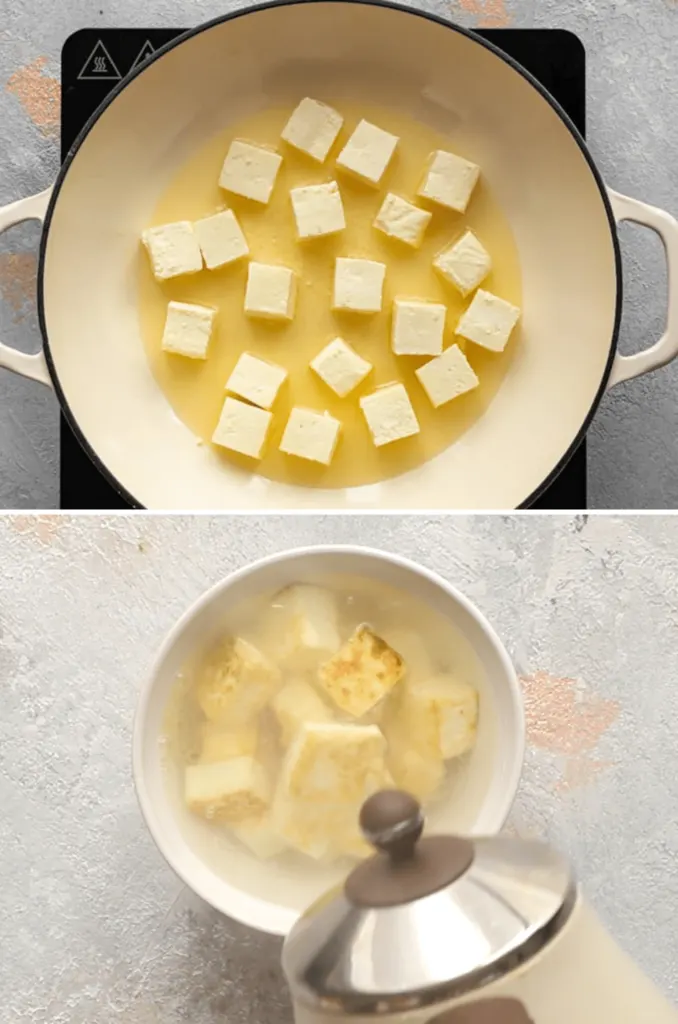
Pan fry the paneer in until golden and then soak in hot water (I just use kettle water) for 5 minutes. After a soak, the paneer will be juicy and squidgy.
Step 4: Temper the spices
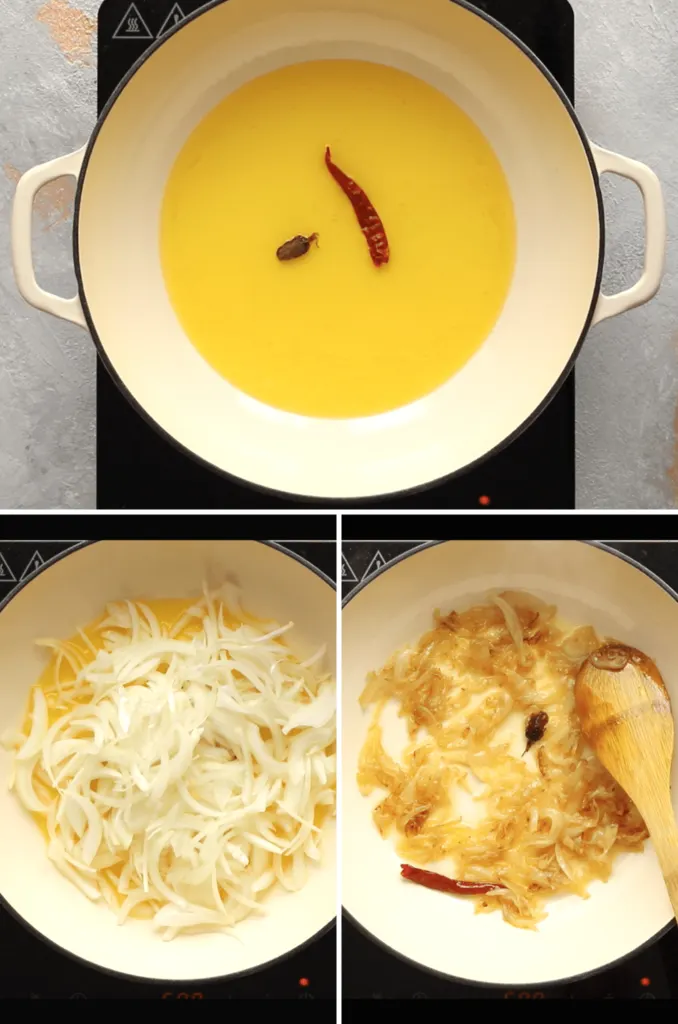
Give the inside of the pressure cooker a quick wipe. Heat butter in the pot and add the dried red chilli, black cardamom and onions. Soften for 20 minutes over a low heat until golden.
Then add sliced garlic and chopped green chillies. Cook for a further few minutes over a med-low heat. The onions should be lightly golden, soft and sweet.

Step 5: Add the saag, season and simmer

Add the saag mixture and stir. Cook for 5 minutes over a low heat, stirring all the time. Be careful as it will bubble and spit. Allow to thicken slightly. Stir in the salt and garam masala.
Step 6: Add the paneer to the saag

Add the drained paneer to the saag and stir well. Heat through and serve piping hot with your favourite roti, paratha or naan.
What to serve with Saag Paneer


Serve this Saag Paneer the traditional Punjabi way with Makki di Roti (Punjabi cornmeal rotis), butter or ghee, onions and chillies.
It might be a little non-traditional but I love Saag Paneer with rice.
Saag Paneer Recipe | How to make Saag Paneer | Punjabi Saag Paneer
Saag Paneer Recipe
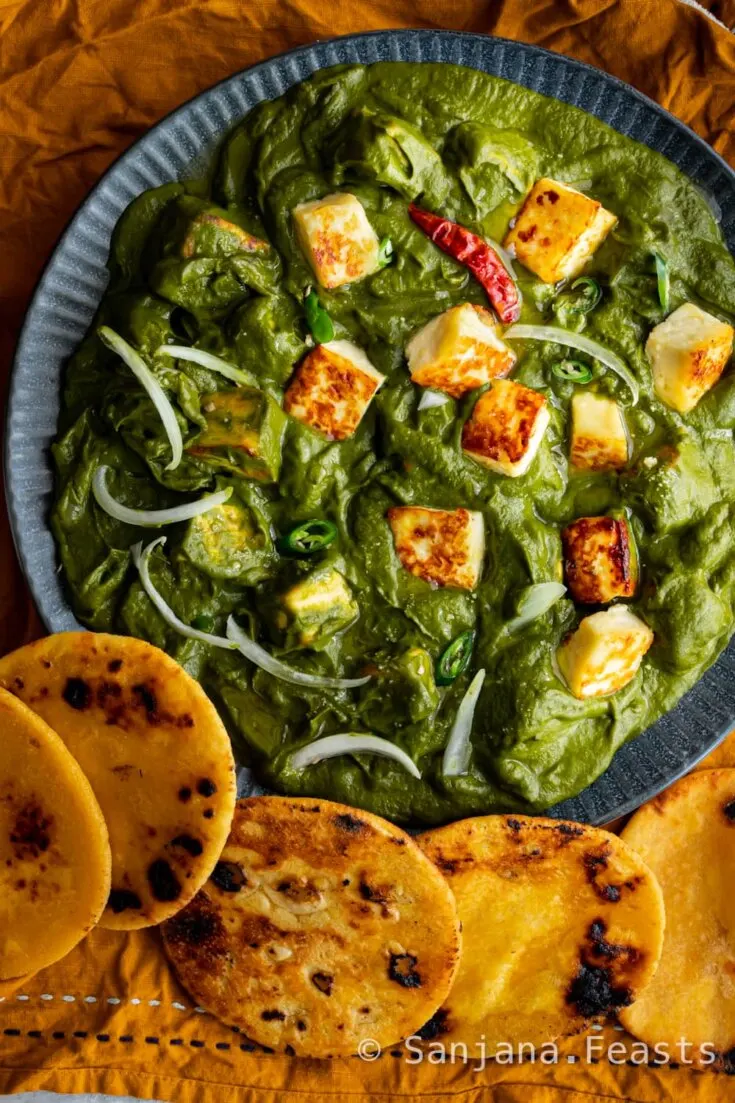
This traditional Punjabi Saag Paneer recipe is pure magic! Soft paneer chunks in a creamy mustard greens and spinach curry. Every bite of this classic Indian curry will melt in your mouth. Make it with any leafy greens you have, although mustard leaves and spinach are the most typical.
Ingredients
- 300 g mustard leaves, washed, roots trimmed
- 300 g spinach leaves, washed, roots trimmed if using mature spinach
- 2 large onions, cut into chunks
- 4 large cloves garlic, peeled
- 6 cm piece ginger, peeled and cut into chunks
- 3 green chillies, chopped
- Small pinch baking soda
- 250 ml water
- 2 tbsp fine cornmeal
- 25 g ghee, or unsalted butter
- 1 tsp salt
- 2 tsp garam masala
- 450 g shop-bought or homemade paneer, cubed
- 2 tsp oil
For the tadka:
- 100g g ghee, or unsalted butter
- 1 dried red chilli, whole
- 1 black cardamom, whole
- 2 large onions, finely sliced
- 3-4 green chillies, chopped
- 4 large cloves garlic, finely sliced
To serve:
- Red onions, finely sliced
- Chopped chillies
- Extra ghee or butter
Instructions
To prepare the mustard greens and spinach
- Wash the mustard greens and spinach thoroughly to remove any dirt or grit. Drain. Finely chop the stalks and then chop the leaves into 1cm shreds. If you're using baby leaf spinach, there's no need to trim or chop it — just add it in whole.

- In a large pressure cooker, add the mustard greens, spinach, onions, garlic, ginger, water and baking soda. Fix the lid onto the pot and cook for 10 minutes (4 whistles). You can also simmer in a pot with a tight-fitting lid for 25-30 minutes or give it 5 minutes of high pressure in an Instant Pot.

- While this cooks, pan-fry the paneer on all sides until golden. Once golden, put the paneer in to a large bowl and add enough boiling water to cover. Soak for 10 minutes and then drain. This will make the paneer chunks extra soft and remove any excess oil.

For the tadka (tempering)
- Melt 100g ghee in the same pot and add the dried red chilli, black cardamom, sliced onions and salt. The salt will help the onions cook quickly. Sauté over a med-low heat for 20 minutes until the onions are lightly golden brown and then add the sliced garlic and chillies. Cook for a further 2 minutes.

- Pour in the blended saag and garam masala. Cook for a further 5 minutes until slightly thickened. Taste and check there's enough salt for you.

- Add the paneer, heat through and serve. This recipe pairs perfectly with paratha, makki ki roti (cornmeal roti) or wholewheat rotis.

Notes
- Store leftovers in an airtight container. Reheat thoroughly before serving.
- Freeze the Saag Paneer in a freezer-safe container for up to 3 months. Defrost at room temperature and ensure food is piping hot before serving.
- For a vegan option: Replace the paneer with firm tofu (no need to soak in water after browning) and use vegan butter.
Nutrition Information:
Yield: 6 Serving Size: 1 gramsAmount Per Serving: Unsaturated Fat: 0g
Pin this Saag Paneer recipe for later!

If you like this, you’ll love my recipe for Matar Paneer
How many calories in Saag Paneer?
I’m not one to count but most Saag Paneer recipes will have between 500-750 calories per portion. You can reduce this by replacing paneer with tofu, using less paneer or cutting down on the butter content.
More delicious Indian recipes to try
10 Paneer Curry Recipes You’ll Love
10 Paneer Curry Recipes You'll Love
Try one of these delicious paneer curry recipes the next time you're cooking up an Indian feast!
Matar Paneer
Matar Paneer is a popular Indian dish made with paneer cheese and peas in a creamy tomato-based sauce. It's a delicious and nutritious vegetarian curry.
This recipe for Matar Paneer is also easy to make, making it an amazing option for home cooks or people new to Indian food.
Matar Paneer is typically served with rice, naan or roti, but feel free to choose your favourite accompaniments.
Restaurant-Style Shahi Paneer
Soft, creamy Mughlai Restaurant-Style Shahi Paneer is a true celebration of rich flavours and treasured spices. Scoop this vegetarian curry up with hot paratha, naan or roti.
If you’re not a bread lover, this Shahi Paneer also pairs beautifully with rice, should you wish to opt for a simple curry and rice bowl for dinner.
Paneer Tikka Masala
Learn how to make the most delicious Paneer Tikka Masala, just like your favourite Indian restaurant!
Pieces of paneer (cottage cheese) and vegetables are first marinated in yoghurt and spices, and then skewered and grilled to smoky perfection.
The tikka pieces are then removed from the skewer and folded into a creamy curry sauce made with tomatoes, spices and cream. Here's an easy to follow video recipe and video.
Brown Butter Paneer Makhani
I thought I knew true love, but then I met Brown Butter Paneer Makhani. The toasty, nutty aroma of brown butter (or beurre noisette) transforms the traditional Paneer Makhani we all know and love into something even more sensational.
Combine aromatic spices with a creamy cashew and tomato base, gently brown some butter in a pan and create the Makhani-style sauce of your dreams. This is the only way I’ll make Paneer Makhani from now on.
Paneer Curry
Try this easy Paneer Curry recipe with a delicious mix of aromatic Indian spices. Sauté the soft cubes of Indian cottage cheese in a golden onion and tomato masala. The flavours of cumin, black pepper, ginger and garam masala add warmth and excitement.
A kadai-fried curry like this (without too much sauce) is perfect to serve with naan, roti or paratha. I even like using it as a dosa filling when making Paneer Masala Dosa. If you prefer your Paneer Curry with a thick Indian gravy, try Paneer Makhani or Matar Paneer.
Melt-Away Malai Kofta
I call this creamy paneer kofta curry Melt-Away Malai Kofta simply because they melt away as soon as you put them in your mouth. Malai Kofta are the ultimate North Indian vegetarian curry recipe to dazzle friends and family.
My simple paneer and potato kofta are golden on the outside and a brilliant white colour on the inside. Each bite is soft, a little spongy and slick with a smooth and creamy tomato sauce. In my home, Malai Kofta is an essential curry for special occasions.
This Indian vegetarian curry of paneer (cheese) and potato kofta is a real celebration of rich flavours and warming spices.
Easy Creamy Palak Paneer
I will always order Palak Paneer if it’s on the menu in a restaurant. For me, a bowl of creamy spinach and cheese is mandatory. I could forgo rice and bread and quite simply eat a bowl of Palak Paneer with a spoon.
The trick to a super green sauce is to cook the spinach as little as possible. Just apply enough heat to wilt it at the beginning and heat the finished sauce just to warm all the ingredients through.
Paneer Butter Masala
One of my favourite paneer dishes is Paneer Butter Masala, whereby chunks of soft paneer are folded into a creamy and sharp tomato sauce made luxurious with unadulterated butter.
Hand me a teardrop sheet of puffy, soft naan to mop up all of that sauce and I’m in seventh heaven.
Restaurant-Style Matar Paneer
The soft and creamy cubes of Indian cottage cheese pairs so well with simple fresh garden peas, making this vegetarian curry a pillar of Desi restaurant and home-style cooking.
The base gravy for this Matar Paneer recipe contains ground almonds and tomatoes for a delectable creaminess and sharp tang.
The spicing is warm but complex, making you wonder if you really just made that at home in the comfort of your own kitchen, without having to go to a restaurant or pick up a takeaway menu. Mad skills.
Love Sanjana


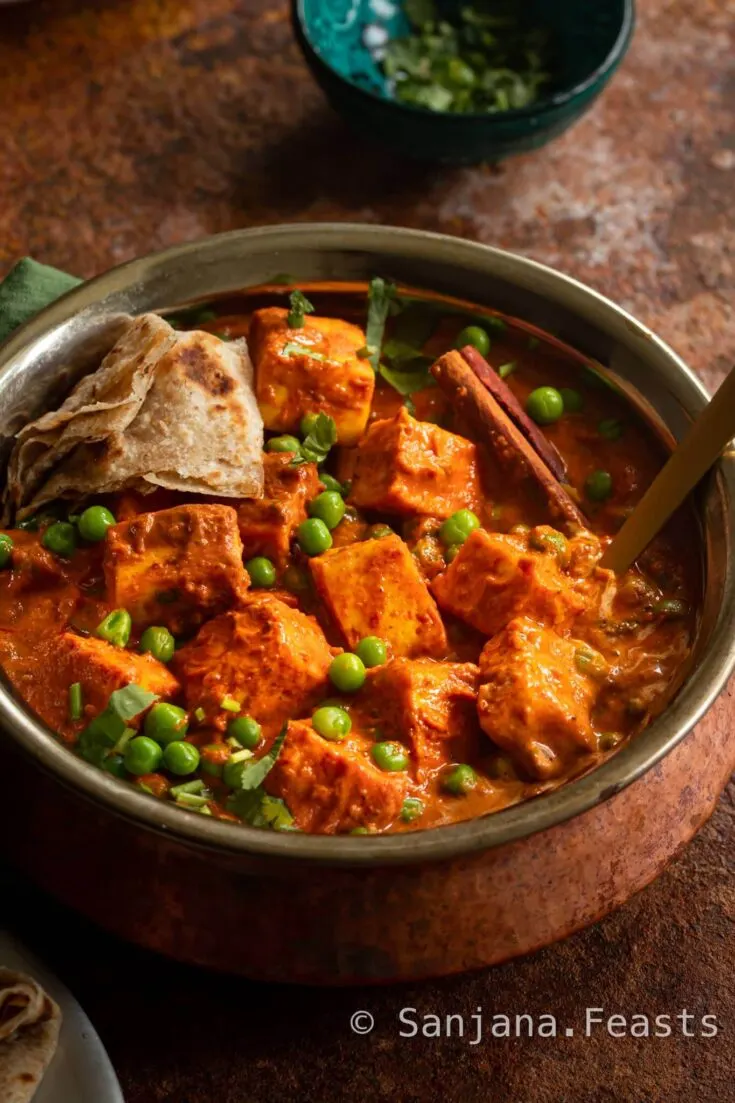
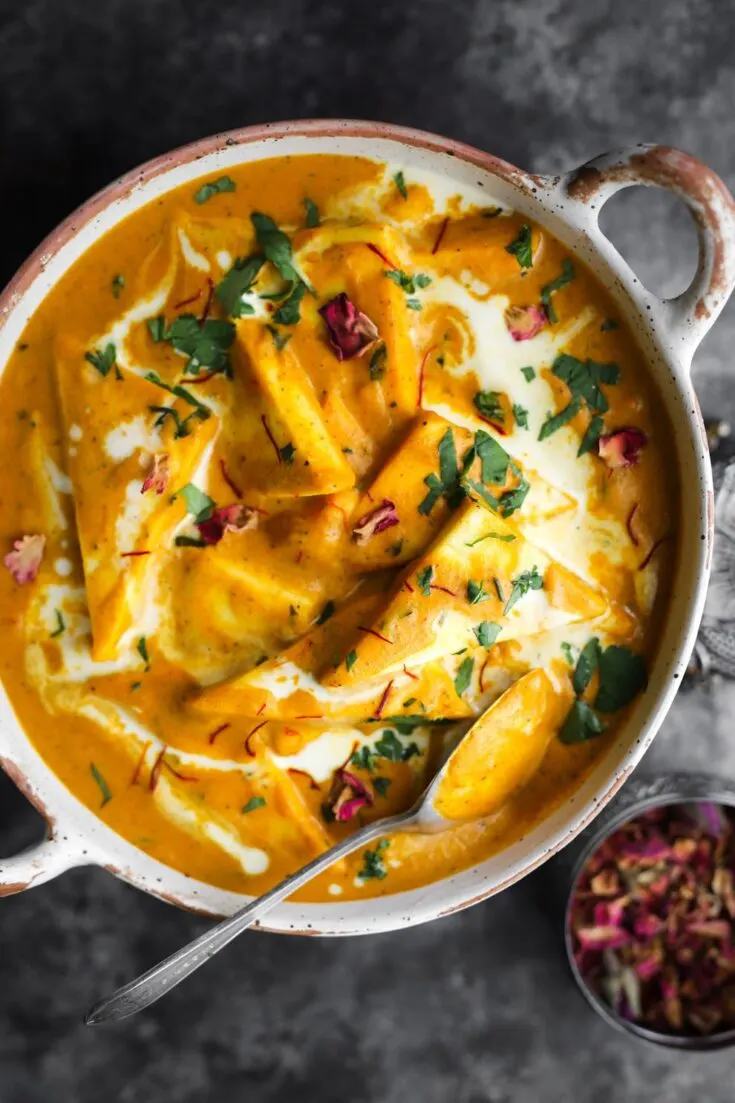
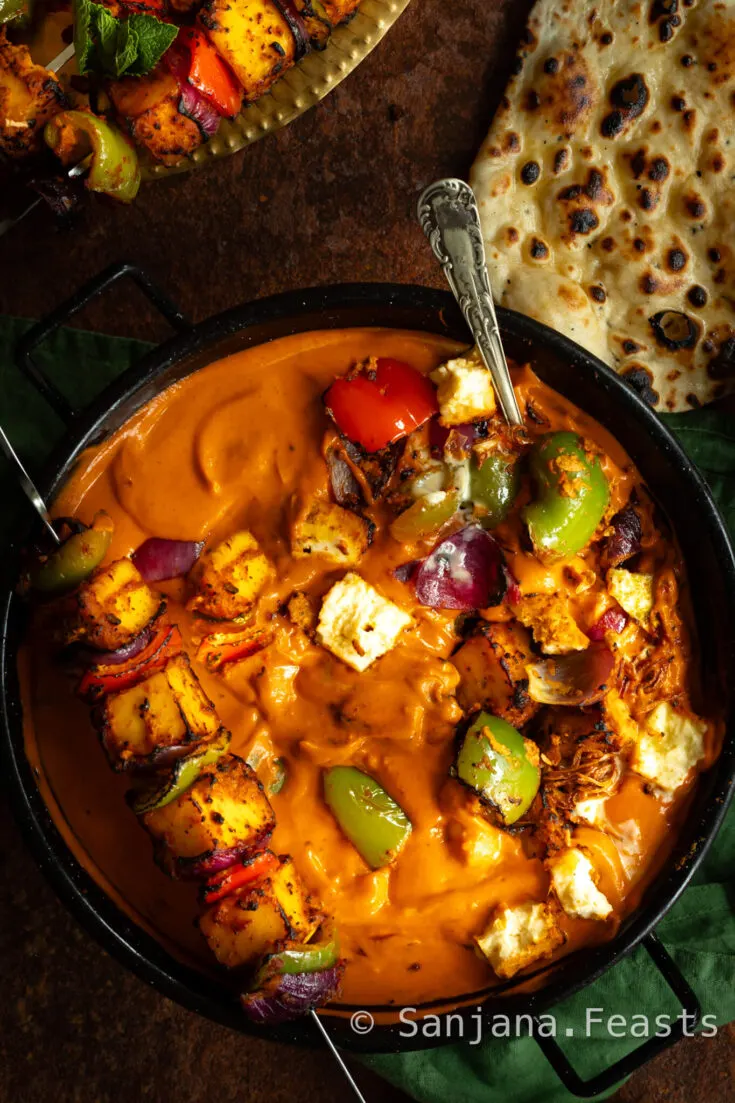
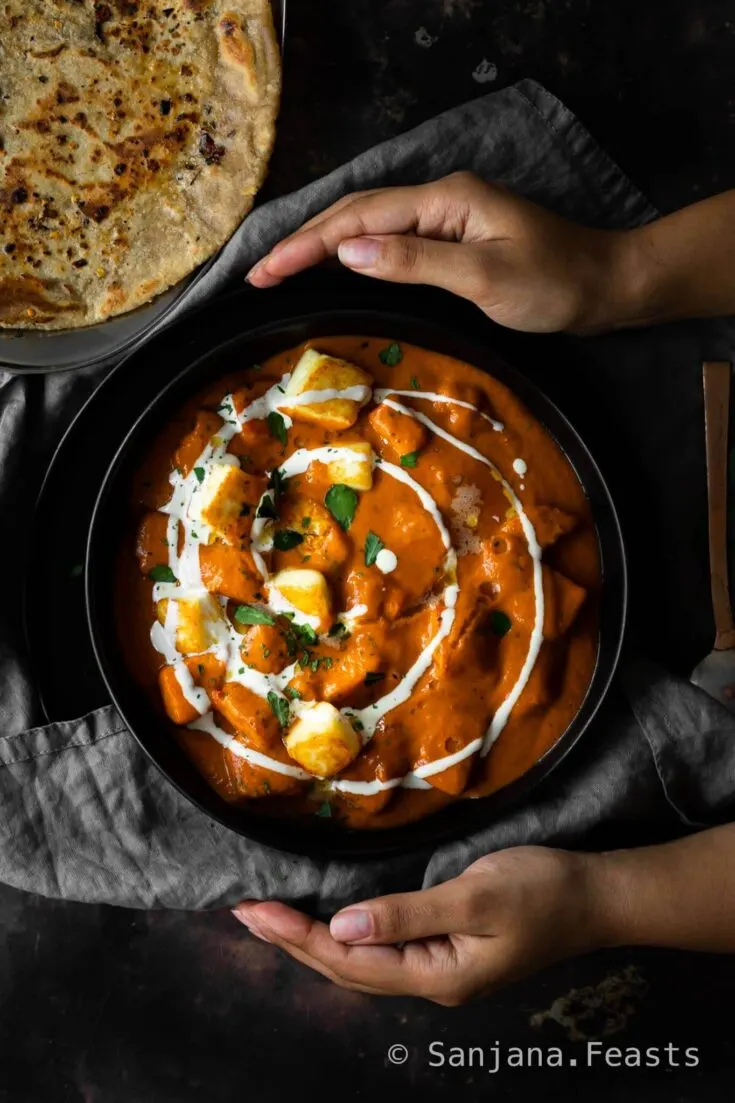
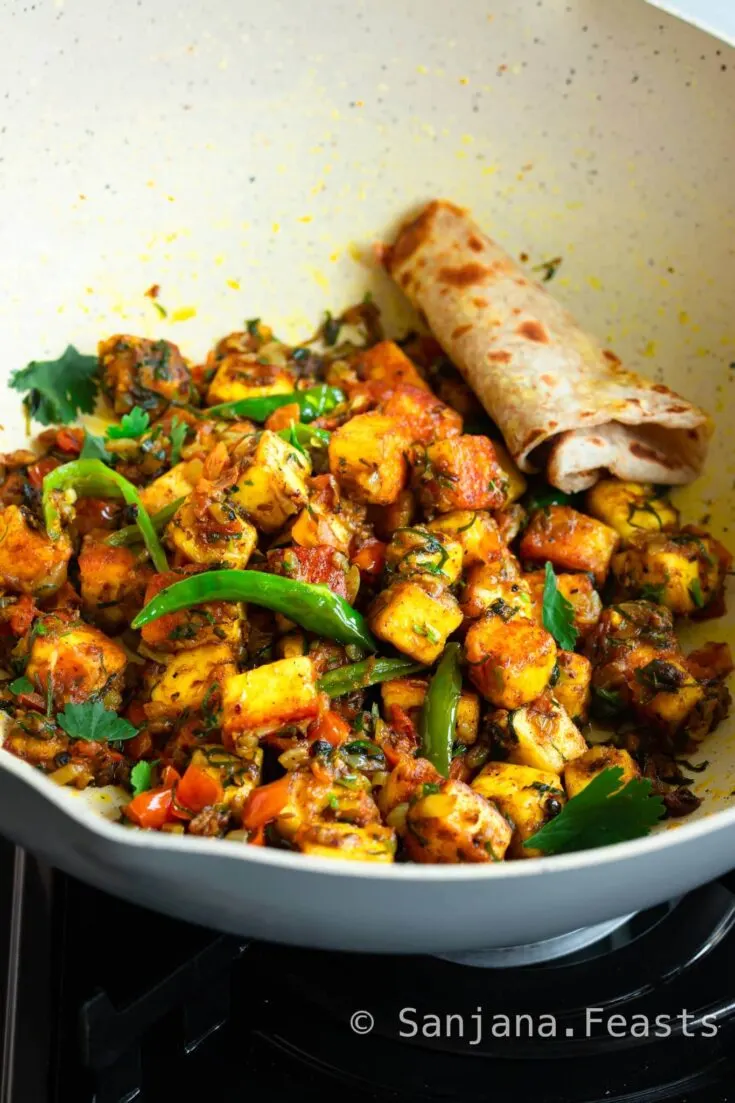
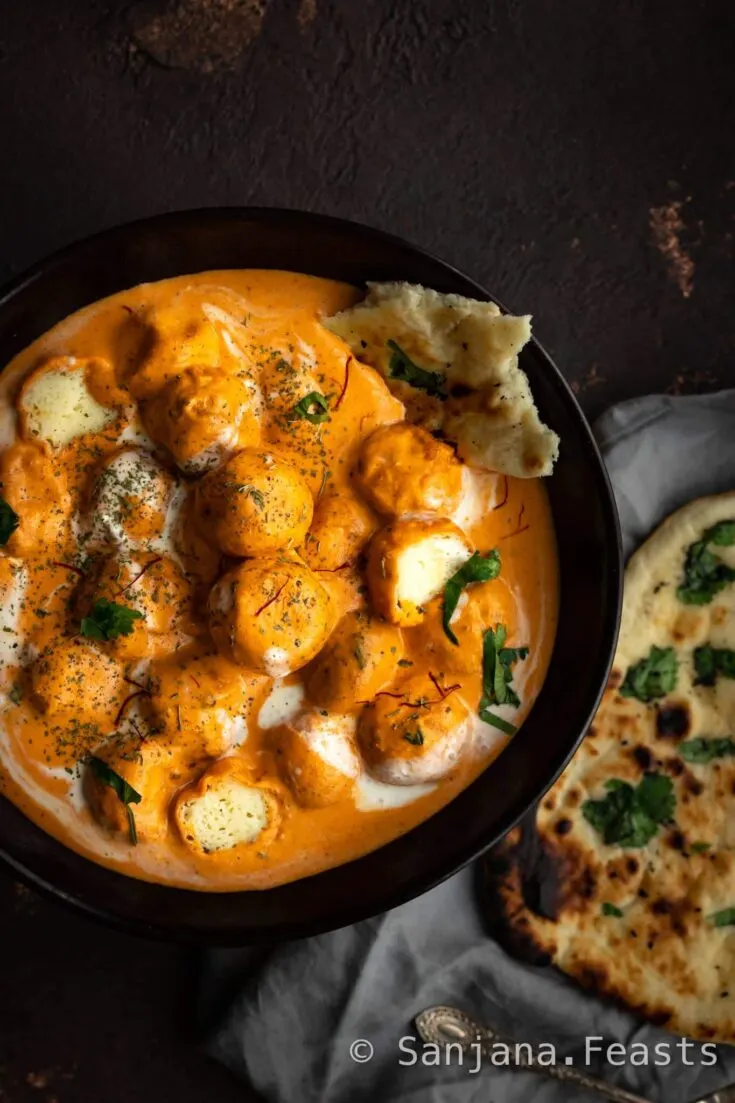
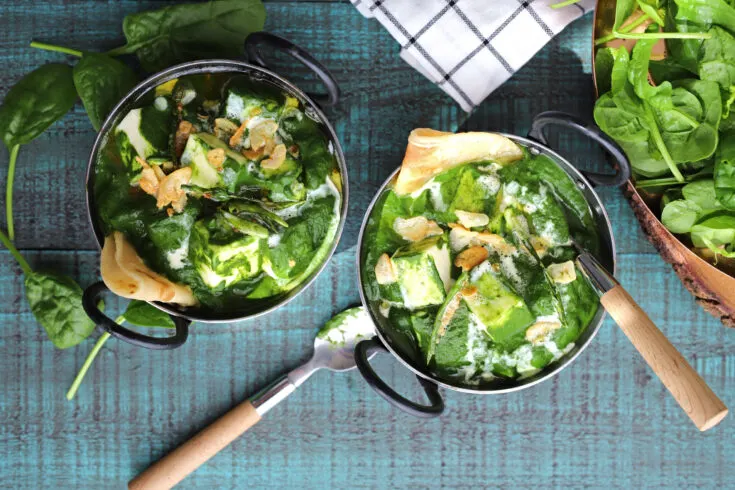
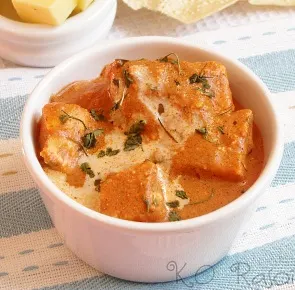
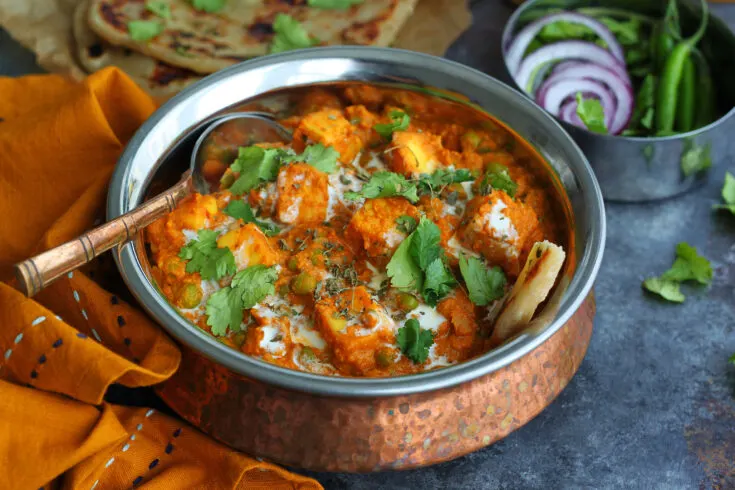
Vegetarian Curry Recipes - Indian Recipes - Sanjana.Feasts
Tuesday 26th of November 2024
[…] Saag Paneer Rajma (Kidney Bean Curry) Tofu Korma […]
Palak Paneer Recipe (Easy, Beginner-friendly) - Indian Curry Recipes
Thursday 8th of February 2024
[…] may or may not know that Saag Paneer and Palak Paneer are two completely different dishes. The names are often used […]
Saag Recipe (VIDEO) - Delicious Punjabi Cooking - Sanjana.Feasts
Thursday 7th of December 2023
[…] Saag Paneer recipe […]
Bal
Saturday 10th of June 2023
Comprehensive recipe and finally the issue regarding palak and zarg which irritates me no end. Will give recipe a go as well as mutter paneer
Sonal Patel
Friday 2nd of September 2022
Hi Sanjana, your makki ki roti looks delicious and I'd love to make this for my kids. Do you have a recipe you can share for this please? I can't seem to find it anywhere unless I have missed it. Thank you x